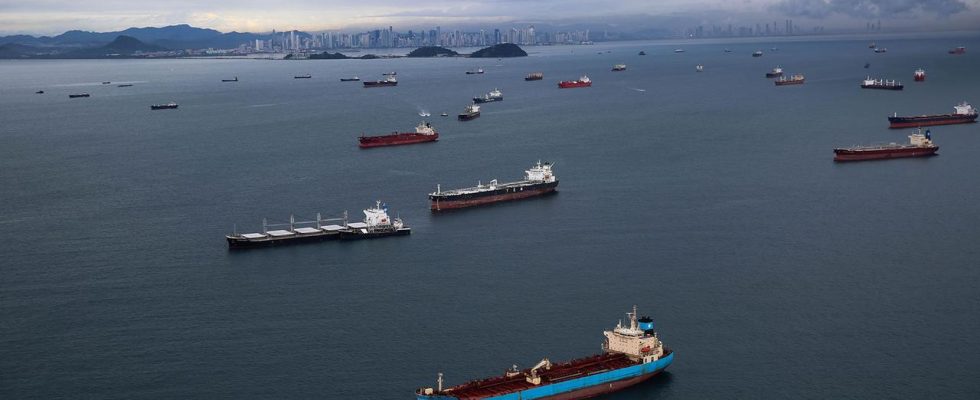Around 90 percent of global trade is carried out by ship. But drought and storms are already causing restrictions. How climate change affects shipping.
Due to drought and a low water level, only 32 instead of the usual 36 ships are currently allowed to pass through the Panama Canal, which is important for the global economy. In addition, the responsible canal authority lowered the maximum draft for the passage between the Atlantic and the Pacific until September 2nd. The measures have caused long waiting times and traffic jams in the past few weeks.
Since the container ships, which are particularly important for the global supply chains, are guided through the canal more quickly and it remains navigable despite the restrictions, the negative effects should be manageable, according to the Kiel Institute for the World Economy (IfW) and the industry. But: Experts assume that such problems will occur even more frequently in the future due to climate change. What does this mean for world trade?
Hurricanes cut trade by 10 percent
“Even in the past, fog, storms and repairs to the locks often led to longer waiting times at the Panama Canal,” says Jasmin Gröschl, an economist at Allianz Research tagesschau.de. However, while it used to happen only once in 20 years that the canal had to restrict traffic due to low water levels, it has now happened twice in the same period.
In general, extreme weather conditions have become more and more frequent in recent decades: According to the United Nations, there were 3,656 extreme weather events between 1980 and 1999, compared to 6,681 in the 19 years that followed. “In an average month, almost four percent of all international shipping routes are now hit by hurricanes – i.e. tropical cyclones of the highest level,” reports Vincent Stamer, trade expert at the IfW. The important west-east route between Europe and East Asia is particularly affected because of its course through the South China Sea.
Due to climate change, Stamer expects even more intense storms in the coming decades – with serious consequences. The shipping companies are forced to either ship goods late or direct them to alternative routes and alternative ports. There is also a safety risk and significantly higher fuel consumption. “On a hit route between two ports, trade falls by about ten percent in a month with a hurricane,” says the expert.
Rising sea levels increase risks
The Association of German Shipowners (VDR) is also observing an increase in extreme weather events. However, stronger storms have always been a major challenge for shipping. Today, “due to the technological possibilities, reliable forecasts and high safety standards of modern merchant ships, one is fundamentally better armed” than in the past.
However, it is not just storms that affect shipping. “The rising sea level affects the functionality of port facilities and seaport approaches, while floods, droughts and low water levels can lead to shipping lanes becoming impassable,” explains Allianz economist Gröschl. The melting of the polar ice sheets could also open up new shipping routes; However, the rising sea level increases the risks for ships and port facilities.
According to Gröschl, this increases costs and insurance premiums and also reduces the efficiency of trade. Shipping traffic in particular plays a decisive role in the global economy. “The sea route dominates global freight transport – around 90 percent is by ship,” she emphasizes.
Spoiled food or stopped production
Reliable navigability of important shipping routes is particularly important for foreign trade nations such as Germany. According to the Federal Statistical Office, goods handling at German seaports amounted to 279.1 million tons last year. Two thirds of German exports leave the country by sea.
If shipping routes are not navigable, this means more time and money, according to Gröschl. An unplanned interruption can lead to food spoiling or production processes coming to a standstill due to missing components. The supply chain service Everstream Analytics recently analyzed four extreme weather events in the United States over the past twelve months. The result: You delay shipments by an average of two or more days. 75 percent of the deliveries are even completely canceled afterwards.
Shipping is particularly vulnerable, “since the transport and logistics chains are heavily networked and the market is highly competitive,” says Gröschl. The high price pressure ensures maximum capacity utilization and tight schedules. In contrast to other traffic routes, according to the expert, there are only limited short-term alternatives, which are often cumbersome or expensive.
Climate-neutral shipping as a solution?
Researchers at Oxford University estimate that climate-related disruptions to ports alone jeopardize an average of $81 billion in global trade and at least $122 billion in economic activity each year. But how can shipping companies arm themselves for the increasing risks? “When the water levels are low, reducing the load is certainly the easiest way and it is also possible to use smaller ships,” explains Gröschl.
Otherwise, shipping could adapt to climate change by improving weather forecasting, modifying route planning and port facilities, and switching to more sustainable shipping technologies. The latter not only helps to combat climate change, but can also reduce operating costs. The VDA also refers to decarbonization with a view to possible solutions. A climate-neutral shipping is “therefore no longer a question of whether, but of how”.
Up until now, the often huge container ships have mainly run on heavy fuel oil or marine diesel, and some also on liquid natural gas (LNG). At the beginning of July, the World Maritime Organization IMO agreed on common goals for climate neutrality for the first time. Greenhouse gas emissions are now to be reduced to zero “by 2050 or shortly thereafter, taking into account the different national circumstances”.

